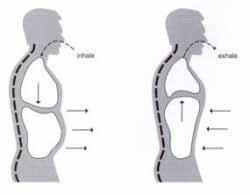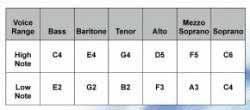
HOW TO
BECOME A
BETTER SINGER

Learning how to become a better singer is quite possible if you follow some
simple steps. Here is a list of the 17 best singing exercises and voice lessons
which are suitable for both beginners as well as for singers at an advanced
level. These vocal exercises are time-tested and proven to improve your singing
voice no matter what level you are at. Professional voice coaches teach these
simple and powerful tricks to budding vocalists to help them reach their full
potential quickly and easily.
#17 Become A Better Singer By Learning How To Breathe
Correctly When Singing
The first step to becoming a better singer is to breathe correctly when you are
singing. Let us take a look at one of the best breathing exercises for singing.
Diaphragmatic breathing or Belly breathing allows you to sing at full power while
maintaining a steady, high-quality voice. As you sing while breathing with your
belly, your voice rides on the exhaled air and creates the best tonal quality.
Belly breathing is especially helpful when singing for long durations of time and
so it is one of the most preferred breathing techniques for singers.
As you start singing, air in your throat starts vibrating and generates sound. This
air keeps on vibrating as you breathe out until you run out of air. If you breathe
only using your upper chest, your sound will be airy and weak and you will
quickly run out of air thus causing your voice to break.
Practicing the following breathing exercise will train you to belly breathing
correctly when you are singing.
1. Lay down with your back on the floor. Keep your knees bent and pointed
upwards towards the ceiling. Keep your feet flat on the ground and your hands
on your sides.
2. Keep a slightly heavy book on your stomach near your waist.
3. Now slowly take a deep breath in through your nose and fill your belly with
air.

4. Notice how the book rises as you inhale. Once you belly is full of air, hold
your breath for 10 seconds.
5. Then gently breathe out using both your nose and your mouth
and watch the book slowly go down. As you breathe out hum a note
or make the sound “Haaa”.
6. Repeat this breathing in and out for 10 more times.
7. You can hum a different note each time you breathe out or make
the same “Haaa” sound each time.
This is possibly the best breath control exercise for singers as it will
gradually build the strength of your abdominal walls and slowly
retrain you to breathe with your belly whenever you sing.
Once you have become comfortable with taking 10 in and out
breaths with the book on your belly, you can then switch to a heavier
book like the yellow pages. After you become comfortable with that
book, then start using multiple heavy books.
As the strength of you abdominal walls and your diaphragmatic
muscles gradually increase you will become much more comfortable
at singing.
Once you are able to comfortably breathe with you belly and sing,
then do this exercise standing up. Only this time instead of the book,
place your hand on your abdomen and press inward. Then breathe
in and expand your belly pushing your hand away from your body.
Remember to always sing a note on the out breath. This simple
breathing tip will help singers get a clear, strong voice of high tonal
quality every time they sing.
Click Here And Discover The Fastest
And Easiest Way To Become A Better Singer
#16 How To Be A Better Singer By Simply Changing Your
Standing Posture

Once you"ve learned to breathe properly when you sing, the next step to get a
better singing voice is to learn proper singing posture.
Standing the right way can make a huge impact on a vocalist"s voice. In proper
singing posture, your will observe the following features.
Chin would be almost parallel to the floor
Shoulders will be pulled back and down and chest held high in a relaxed
position
Abdomen would be flat and firm and set in an position where you can
expand it easily
Hands will be relaxed and motionless on your sides
Knees would be loose, flexible and unlocked
Feet will be shoulder width apart and one foot would be slightly in front of
the other
You can get a feel for what it is like to be in proper singing posture, by practicing
the below exercise.
1. Stand up against a wall with your head, shoulder, buttocks, calves and heels
touching the wall.
2. Notice how your spine stretches and becomes erect in this posture.
3. Now shift the weight of your body forward until you are almost standing on
the tips of your toes. Feel the sense of floating balance as you are in this
position.
4. Then step away from the wall, stand in a slouched manner and notice how it
feels different.
5. Step back to the wall and repeat steps 1 to 4 and take notice again of how it
feels to stand erect in an almost floating state.
6. Now step away from the wall, maintain this erect posture and practice
singing.

Proper singing posture is very vital for anyone who wants to learn how to
become a better singer. Don"t underestimate the power of this simple technique.
It is often the first thing taught in professional voice training classes by vocal
coaches.
#15 How To Get A Better Singing Voice Fast By Understanding
Your Three Voices
It is a common misconception among novice vocalists that head voice, middle
voice and chest voice are 3 separate registers (sections of voice) independent
of each other. This is not true. In reality there are four different vocal registers
but only one register, the modal register is used in singing. The modal register
is manipulated during singing to produce, the head, middle and chest voice.
You simply cannot flip a switch and turn off your chest voice and move into
head voice or vice versa. Believing that these 3 voices exist independent of
each other may make a beginner feel that it is quite difficult to manipulate their
voice during singing to produce the appropriate note.
There is a smooth continuum between head voice, middle voice and chest
voice. These terms don"t refer to 3 different registers, but a single register which
resonates in different regions of your body.
Before your voice leaves your body it resonates with different structures inside
your body. The kind of voice you produce will depend on which body part your
voice is in maximum resonance with.
Head Voice
When a singer in using their “head voice” it means they will feel vibrations
around the upper half of their face, because, during head voice the main body
part in resonance with their voice is their sinuses. However, this does not imply
that other vocal parts are not resonating. It only means that the most amount of
resonance is happening in their sinuses as compared to any other part.
Middle Voice
When a vocalist sings in their “middle voice” they feel most of the vibrations
around the lower half of their face, their chin, and upper neck. In this scenario,
the vocal structure in maximum resonance is their hard palate (roof of the
mouth). Again, this doesn"t imply that remaining structures aren"t vibrating. Their
chest and sinuses also contribute, but to a much lower degree.

Chest Voice
When a songster in using their “chest voice” most of their sound vibrations are
felt around their lower neck, and chest area. This is the voice most people use
during regular speaking. If you put your hand at the center of your chest when
you speak, you can feel it vibrating. This is the chest voice.
These 3 voices form a continuous spectrum with the head voice at one end and
the chest voice at the other end. With regular practice you will be able to carry
your voice comfortably from one end of the voice spectrum to other end without
your voice breaking. You can also mix you resonance areas, to produce all
kinds of mixtures between chest, middle and head voice.
Here are some fun exercises which will help you get a feel for your 3 voices.
Hum a note, and slowly move the pitch of your voice up and down.
Close your eyes and feel as the sound vibrations move inside your body.
Notice how the intensity and region of vibrations change as you change
the pitch of your voice.
Sing each of the vowels A, E, I, O and U and notice in which body region
each vowel resonates most. Does “EE” resonate in a different area than
“O” or “A”?
Pretend you are yawning as you are singing a note. Notice how it
changes the vibrations.
Now pretend to buzz like a bee while humming a note.Play around with
you voice and notice the difference in each of these three voices. It will
help you become a much better singer.
#14 How To Get A Great Singing Voice By Building A Daily
Practice Routine

This may sound like an obvious fact but this is actually the most important
action you can take in your journey to becoming a better singer. Practice
singing daily. Practice truly does make you perfect. Repetition is the mother of
skill.
As you train your voice and mind over and over again, you will slowly hand over
the more difficult nuances of singing to your unconscious mind. In time you will
reach a point where you will be able to sing completely on auto-pilot with very
little conscious effort.
There is only one way to reach this level of mastery and that is through constant
practice. Recent research has revealed that every person who is a master in
their field has practiced their skill for at least 10,000 hours. Same is true for
world-class singers also.
These 10,000 hours may seem like a lot at first, but when you break this down
into regular practice sessions, day after day, month after month, year after year,
that target will seem smaller and smaller.
The trick to building a successful daily practice routine for singing is to turn it
into a habit. Pick a time of day and a place where you can practice singing for at
least an hour without any interruptions. Turn off your cellphone and lock your
door. Perform some warm up vocal exercises to get yourself into a singing
mood.
It is important to practice your singing at the same time and same place every
day, because by doing this, in just a few weeks, your mind wil get “primed” for
singing as soon as you enter your practice room at that time of day.
Once you have built a habit out of it, then you will no longer need to put as
much effort into your singing. Your brain will automatically bring you into the
perfect mental state for singing as soon as you start your practice.
#13 How To Improve Your Singing Voice Quickly By Modifying
Your Diet
Foods you eat on a regular basis and foods you consume immediately before
singing both have a huge impact on your voice as well as mental state. Some
foods can greatly help your singing while others can do great damage. One of
the simplest tips for singing better is to change your diet so that you avoid foods
that hurt your voice and eat foods that help you sing better.
Bad Foods That Can Hurt Your Singing Voice
Alcohol: Alcohol increases the diameter of your blood vessels and
causes them to swell. That can be very harmful for your voice box. When
your blood vessels are swollen, blood thins out and arrives closer to the
surface thus increasing the chances of hemorrhaging your vocal cords
when you sing. Alcohol also dehydrates your body so you should drink
plenty of water on days you drink. Alcohol also delays your reaction time
and makes you lose co-ordination of your vocal muscles. You must
control your alcohol intake and completely avoid it on days when you
have a performance.
Caffeine: Like alcohol, caffeine dehydrates your body by making it lose
water quickly. It will make your throat dry out faster. Dry vocal chords
make you sound hoarse and severely limit your vocal range and
endurance. If you do have to drink coffee, choose decaf instant coffee
rather than filtered coffee. Also make sure to drink plenty of water later to
rehydrate your body.
Dairy Products: Milk, butter, cheese and other dairy products increase
the thickness of the mucous present in your airway making it more
difficult for your vocal chords to produce sound. Avoid any kind of dairy
before a show.
Smoke: Any kind of smoke, from cigarettes or anything else will cause
inflammation of the tissue in your throat which will drastically affect your
vocal chords. Long term exposure to smoke can even cause permanent
damage to your voice.
Spicy Foods: Foods that are too spicy will irritate your throat and
produce discomfort when singing.
Sodas and Cold Drinks: These will fill your stomach with gas and make
it hard for you to breathe and sing comfortably. Drinking too many of
them can also end up giving you a sore throat.
Good Foods That Can Help Your Singing Voice
Water: Drink at least 8 glasses of water a day to keep your vocal chords
hydrated, toned and healthy.

Honey & Lemon: Both honey and lemons have anti-microbial properties
that help to kill any resident germs in your throat. They help prevent sore
throat and also sooth your vocal chords. Honey is also a good source of
energy that will invigorate you and put you in better emotional state for
singing.
Ginger Tea: It can be a great substitute for coffee as it has the same
energy boosting capability of coffee without containing any caffeine. It
also has anti-bacterial properties that helps heal and prevent sore throat.
Green Leafy Vegetables: These vegetables are a good source of
energy and they help maintain a healthy and strong voice. They reduce
swelling and inflammation of the throat and boost your immune system.
Salt Water Gargling: Gargling with warm salt water every night before
going to bed is an effective way to avoid sore throats and keep your
vocal chords in top condition.
Find Out How You Can Get Better Control On Your Singing
Voice And Increase Your Range By A Full Octave By
Clicking Here
#12 How To Train Your Voice For Better Singing By Re-
Conditioning Your Mouth And Jaw

Here is a voice training exercise that will quickly train your mouth and jaw to
make you singing sound better.
1. Stand in front of a mirror and say A…E…I…O…U. Watch your jaw
movement as you say each vowel. Did you close your mouth while
speaking any of the vowels? You most likely closed your jaw on E and U.
2. Now take the first two fingers of your left hand and put them in your
mouth. This will lower your jaw about two inches. If you don"t want to use
your fingers, you can also use a cork or bottle cap to hold your jaw open.
3. Speak the vowels once more and notice how your tongue and throat
move a bit differently this time. Now repeat the vowels five more times.
4. Then take out your fingers from the mouth and speak the vowels again,
this time taking care that your jaws don"t close on any of the vowels.
5. Once you can successfully speak the vowels then practice singing the
vowels in a single pitch. Again take care that your jaw and mouth don"t
close.
6. After you have successfully mastered singing the vowels with your mouth
open, now practice singing few phrases from a song keeping your mouth
open.
If you perform this exercise correctly and regularly, very soon you will notice an
improvement in your voice.
You will sound more resonant and louder. Also you will put lesser strain on your
voice when singing louder. This exercise will also release any unconscious
tension you may be holding in your throat, jaw or neck muscles.
#11 How To Master Singing By Adding More Emotion To Your
Voice
Every song has an emotion attached to it like happiness, sadness, anger or
guilt. Sometimes the same song can go through multiple emotions at different

verses. The seasoned vocalist knows how to bring the right emotion into their
voice when singing a song.
This may not feel like a vocal technique for singers but with just a little practice
you will quickly notice the difference in your voice.
First part of this trick to add more emotion in your voice is to simply change your
facial gestures and body language to match the emotion of the song you are
singing. If you are singing a happy song, put a big smile on your face. If you"re
singing a sad song, then make a sad face.
The second and more important part of the trick is to think thoughts that
naturally produce the appropriate emotion. So if you are singing a song about
sorrow and pain, think of a time in your life when you felt sorrow and pain.
See the things you saw at that time in your mind, listen to the sounds you heard
at the time and feel the feelings you felt in your body at the time. Live that
moment again in your mind and your voice will naturally change and produce
the appropriate emotion in it.
This may seem difficult at first especially if you are singing a song from memory.
It is better to read the song when you practice this technique so that you can
focus on just thinking the right thoughts.
After few practice sessions, you will be able to evoke the right emotion for the
right song and modulate your voice for maximum impact on your audience.
#10 How To Develop A Better Singing Voice By Feeling And
Improving Your Vibrato
Vibrato is a vocalist"s ability to produce a slight, steady and even tonal
oscillation of the center of a pitch.
Vibrato occurs when your voice changes quickly between two pitches. For
example, if you were to sing a C note, and then sing a C# and then sing a C
again, then a C# and then again a C, you would be singing with vibrato.
The secret to a great vibrato is the speed with which you oscillate between the
two pitches.
If you can change between the two pitches at a speed of

















